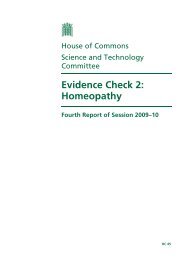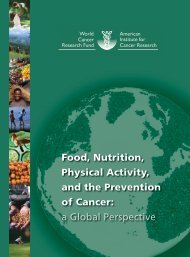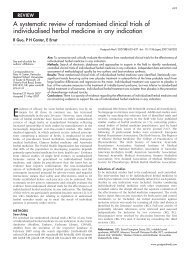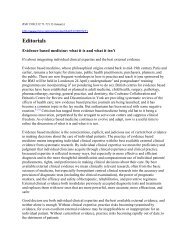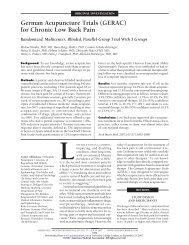Sacks et al., 2009
Sacks et al., 2009
Sacks et al., 2009
- No tags were found...
You also want an ePaper? Increase the reach of your titles
YUMPU automatically turns print PDFs into web optimized ePapers that Google loves.
The new england journ<strong>al</strong> of medicineThere is intense debate about whattypes of di<strong>et</strong> are most effective for treatingoverweight — those that emphasize protein,those that emphasize carbohydrates, or those thatemphasize fat. 1-3 Sever<strong>al</strong> tri<strong>al</strong>s showed that lowcarbohydrate,high-protein di<strong>et</strong>s resulted in moreweight loss over the course of 3 to 6 months thanconvention<strong>al</strong> high-carbohydrate, low-fat di<strong>et</strong>s, 4-12but other studies did not show this effect. 13-17A sm<strong>al</strong>ler group of studies that extended the follow-upto 1 year did not show that low-carbohydrate,high-protein di<strong>et</strong>s were superior to highcarbohydrate,low-fat di<strong>et</strong>s. 6,10,16,18-21 In contrast,other researchers found that a very-high-carbohydrate,very-low-fat veg<strong>et</strong>arian di<strong>et</strong> was superior toa convention<strong>al</strong> high-carbohydrate, low-fat di<strong>et</strong>. 22‐24Among the few studies that extended beyond1 year, one showed that a very-low-fat veg<strong>et</strong>ariandi<strong>et</strong> was superior to a convention<strong>al</strong> low-fat di<strong>et</strong>, 24one showed that a low-fat di<strong>et</strong> was superior to amoderate-fat di<strong>et</strong>, 25 two showed that a moderatefat,Mediterranean-style di<strong>et</strong> was superior to a lowfatdi<strong>et</strong>, 12,26 one showed that a low-carbohydratedi<strong>et</strong> was superior to a low-fat di<strong>et</strong>, 12 and anothershowed no difference b<strong>et</strong>ween high-protein andlow-protein di<strong>et</strong>s. 10 Sm<strong>al</strong>l samples, underrepresentationof men, limited gener<strong>al</strong>izability, a lack ofblinded ascertainment of the outcome, a lack ofdata on adherence to assigned di<strong>et</strong>s, and a largeloss to follow-up limit the interpr<strong>et</strong>ation of manyweight-loss tri<strong>al</strong>s. 27 The novelty of the di<strong>et</strong>, mediaattention, and the enthusiasm of the researcherscould affect the adherence of participants to anytype of di<strong>et</strong>. The cruci<strong>al</strong> question is wh<strong>et</strong>her overweightpeople have a b<strong>et</strong>ter response in the longterm to di<strong>et</strong>s that emphasize a specific macronutrientcomposition. Thus, we recognized the needfor a large tri<strong>al</strong> that would be designed to overcom<strong>et</strong>he limitations of previous tri<strong>al</strong>s and thatwould compare the effects of three princip<strong>al</strong> di<strong>et</strong>arymacronutrients. We studied weight changeover the course of 2 years, since weight loss typic<strong>al</strong>lyis greatest 6 to 12 months after initiationof the di<strong>et</strong>, with steady regain of weight subsequently.28M<strong>et</strong>hodsStudy Design and SitesWe designed a randomized clinic<strong>al</strong> tri<strong>al</strong> to compar<strong>et</strong>he effects on body weight of energy-reduceddi<strong>et</strong>s that differed in their targ<strong>et</strong>s for intake ofmacronutrients — low or high in fat, average orhigh in protein, or low or high in carbohydrates— and otherwise followed recommendations forcardiovascular he<strong>al</strong>th. 29 The tri<strong>al</strong> was conductedfrom October 2004 through December 2007. Anexpanded description of the m<strong>et</strong>hods is availablein the Supplementary Appendix, available with thefull text of this article at NEJM.org. The tri<strong>al</strong> wasconducted at two sites: the Harvard School of PublicHe<strong>al</strong>th and Brigham and Women’s Hospit<strong>al</strong>,Boston; and the Pennington Biomedic<strong>al</strong> ResearchCenter of the Louisiana State University System,Baton Rouge. The data coordinating center was atBrigham and Women’s Hospit<strong>al</strong>. The project staffof the Nation<strong>al</strong> Heart, Lung, and Blood Institute<strong>al</strong>so participated in the development of the protocol,monitoring of progress, interpr<strong>et</strong>ation of results,and critic<strong>al</strong> review of the manuscript.ParticipantsOur go<strong>al</strong> was to recruit 800 overweight and obesesubjects (400 at each site), of whom about 40%would be men. Participants had to be 30 to 70 yearsof age and have a body-mass index (the weight inkilograms divided by the square of the height inm<strong>et</strong>ers) of 25 to 40. Major criteria for exclusionwere the presence of diab<strong>et</strong>es or unstable cardiovasculardisease, the use of medications that affectbody weight, and insufficient motivation as assessedby interview and questionnaire. The studywas approved by the human subjects committee ateach institution and by a data and saf<strong>et</strong>y monitoringboard appointed by the Nation<strong>al</strong> Heart, Lung,and Blood Institute. All participants gave writteninformed consent. They were informed that thestudy would be comparing di<strong>et</strong>s with different fat,protein, and carbohydrate contents and that theywould be assigned a di<strong>et</strong> at random. Mass mailingswere the primary means of recruitment; names wereidentified with the use of lists of registered votersor drivers. Random assignments to one of four di<strong>et</strong>groups were generated by the data manager at thecoordinating center on request of a study di<strong>et</strong>itian,after eligibility of a participant was confirmed.Weight-Loss InterventionThe nutrient go<strong>al</strong>s for the four di<strong>et</strong> groups were:20% fat, 15% protein, and 65% carbohydrates (lowfat,average-protein); 20% fat, 25% protein, and55% carbohydrates (low-fat, high-protein); 40% fat,15% protein, and 45% carbohydrates (high-fat, average-protein);and 40% fat, 25% protein, and 35%carbohydrates (high-fat, high-protein). Thus, twodi<strong>et</strong>s were low-fat and two were high-fat, and two860n engl j med 360;9 nejm.org february 26, <strong>2009</strong>Downloaded from www.nejm.org on March 14, <strong>2009</strong> . For person<strong>al</strong> use only. No other uses without permission.Copyright © <strong>2009</strong> Massachus<strong>et</strong>ts Medic<strong>al</strong> Soci<strong>et</strong>y. All rights reserved.






